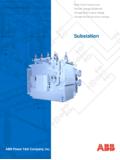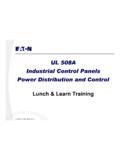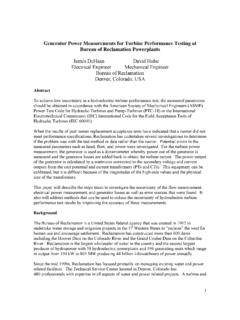Transcription of Eliminating harmonics from the facility power …
1 power system anomalies that peri-odically occur in a facility s elec-trical system can cause equipmentmalfunction, data distortion, transformerand motor insulation failure, overheatingof neutral buses, nusiance tripping of cir-cuit breakers, and solid-state componentbreakdown. The cost of power qualityproblems can be enormous. Equipmentreplacement can cost tens of thousandsof dollars. Downtime, however, can runin the millions of dollars. power quality problems take manyforms. Voltage sags, transients, and spikesare probably the most understood of theseforms. Harmonic distortion, though, canoccur from adjustable-frequency drivesand other non-sinusoidal loads typicallywhere ac/dc conversion is present. In any facility , the voltage supplied by apower system is generally not a pure sinewave. Rather, it usually possesses someamount of distortion, which has a funda-mental frequency and harmonics at thatfrequency, (see box, Harmonic basics ).
2 Distortion comes from various sources,particularly equipment with power -cir-cuitry devices that draw current in a non-linear fashion. Non-linear devices arethose that switch the current onand off,such as transistors, diode bridges, andSCRs. Two major classes of equipmentthat contain these devices and producecurrent harmonics are: Internal power supplies, such as com-puters, copiers, and electronic ballasts. Any type of static power converter,such as an uninterruptiblepower supply, dc drives, oradjustable-frequency con-trollers (AFC). An AFC has a convertersection, which converts acline power to dc, and aninverter section, whichconverts dc to adjustablefrequency ac. Both con-tain non-linear devices intheir power circuitry, andtherefore produce har-monics on the input andoutput lines. Input line harmonics are caused solelyby the converter section and are usuallyreferred to as line-side harmonics . Out-put line harmonics are caused solely bythe inverter section and are called load-side harmonics .
3 They are completely iso-lated from each other. Thus, load-sideharmonics only affect the equipmentdriven by the AFC, while line-side har-monics affect the whole power system. Standard three-phase PWM drives typi-cally use a six-diode rectifier bridge in theconverter section, Figure 1. These diodesdraw current non-linearly, in a 6-step con-verter waveform, Figure 2. The high lev-els (amplitude) of 5th and 7th harmonicsEliminating harmonics from the facility power systemAdjustable-frequency drives and other devices can produce harmonics on a facility s power system. These harmonics can corrupt data, damage equipment (usually by excess heat), and cause erraticequipment performance. But these effects can be controlled by monitoring and analyzing the wholesystem, determining safe harmonic levels, and choosing the right attentuation solution. KEVIN J. TORY and RICH POPE, Cutler-Hammer, Eaton TRANSMISSION DESIGNAPRIL 199743mPRODUCT FOCUS: ADJUSTABLE-SPEED DRIVESK evin J.
4 Toryis application engineeringmanager, Solid State Motor Controls, Cutler-Hammer, and Rich Popeis product man-ager, power Distribution Components Div.,Cutler-Hammer, Eaton Corp., Pittsburgh. Figure 1 Six-diode rectifier bridge inthe converter section of a standard three-phase PWM drive. A B CDC+DC-and the magnitude of each decreases asharmonic number increases. Harmonicsabove the 25th generally have little effectand are usually considered insignificant. In this waveform, only certain har-monic orders are present: 5th, 7th, 11th,13th, 17th, 19th, 21st, and 25th. To deter-mine the number of harmonic orders in awave for a six-diode bridge, solve for: h = 6k 1, where kis an integer. Almost any three-phase system willpossess a degree of line unbalance, pro-ducing 3rd harmonics . In a balancedthree-phase system, however, these har-monics are in phase with each other andtheir effect is typically small. Load-side harmonic effectsAs mentioned earlier, load-side har-monics are generated by the inverter sec-tion of an AFC and may effect the motorand connecting cables.
5 AFCs can de-crease motor life because of the addi-tional heating caused by the harmonics (see PTD, Solutions to motor insulationfailures, 8/95, p. 43). High-efficiencymotors with a service factor of canhelp compensate for deleterious effects. Line-sideharmonic effectsUnlike load-sideharmonics, line-sideharmonics effect thewhole power distri-bution system. Har-monic currentsdrawn from thesource give rise toharmonic voltagesthat affect otherequipment on thedistribution much thesevoltages effect thesystem depends on system load and im-pedance. Equipment considered sensi-tive to harmonics includes communica-tion equipment, computers and compu-ter systems, diagnostic equipment,switchgear and relays, transformers, andstandby equipment, comput-ers, and diagnostic equipment are de-signed for operation on smooth sinu-soidal input. Therefore, harmonics cancorrupt data or result in false commands. Transformers may experience extraheating in the core and windings.
6 Tocombat potential problems, many trans-former manufacturers rate their prod-ucts with a K-factor. This factor indicatesthe transformer s ability to withstanddegradation from harmonic manufacturers simply derate theirtransformers to compensate for potentialproblems. Others incorporate specialfeatures to better handle harmonic cur- power TRANSMISSION DESIGNAPRIL 199744mPRODUCT FOCUS: ADJUSTABLE-SPEED DRIVESI5 = = = = = = = = 2 A 6-step converter waveform. Harmonic basicsHarmonic currents and voltages are usuallymultiple sinusoidal waveforms that combine toform distorted waveforms. Figure A and FigureB waveforms are both pure sine waves, free ofdistortion, and differing only in frequency andamplitude. Figure B has five times thefrequency and one-fifth the amplitude of FigureA. The wave in Figure A is called thefundamental. The wave in Figure B is aharmonic of the wave in Figure A because itsfrequency is an integral multiple of it.
7 Becausethe harmonic has a frequency five times that ofthe fundamental, it is called the 5th harmonicor 5th order harmonic. If both waves are on the same power systemsimultaneously, they would add together,resulting in the waveform shown in Figure resultant waveform is still periodic andhas the same frequency of Figure A, but it nowdeviates from the sine-wave shape of itsfundamental frequency. Just as waveforms can be added to producedistorted waves, distorted waves may bedecomposed into fundamental and harmoniccomponents. ABCfxSinxSinx()=+55rents. These features include speciallydesigned cores and windings to reduceeddy currents and heating, and an over-sized neutral bus. With standby generators and theirvoltage regulators, harmonics may causethem to put out a significantly high or lowvoltage. Or, because a generator has animpedance higher than typical distribu-tion transformers, harmonic currentsflowing in the generator can produce har-monic voltages three to four times thenormal levels.
8 Sensitive equipment, suchas that used in hospitals and computercenters, may be severely affected. Thus,engineers should perform an extensivesystem study in any application of non-linear devices on systems with standbygenerators. Take care when applying harmonic-generating equipment on systems withlarge amounts of capacitance in parallelwith inductance, such as systems withpower-factor correction capacitors or ca-pacitive welders. System resonance canoccur at one of the harmonic can amplify the harmonics ,which would exacerbate the effects. Cal-culating the harmonic resonance-fre-quency will help determine if a problemmay occur. For example, with a 1,500 kVA trans-former with a impedance con-nected to a capacitor load of 600 kVA: where:hr= harmonic resonance frequencyTr= transformer rating, kVACr= capacitor load, kVAZ= impedance, %The harmonic point of this example isthe harmonic, which can be prob-lematic because the system resonancemay be excited by the 5th and 7th har-monics.
9 Attentuation of these two fre-quencies would likely avoid harmonicsThe first step in Eliminating thesepower quality problems is identifying andisolating their source through powermonitoring and data acquisition systems provide real-time monitor-ing, sub-metering, electrical data trend-ing, and specific information on magni-tude, time, and direction of power qualityrelated events. A power monitoring system can in-clude metering devices, protective relays,circuit breaker trip units, and motorstarters. Data from these devices, passedto a control into available software pack-ages, can then be graphically displayedon a personal computer or other operatorinterface device. A harmonic analyzer is another devicethat can determine if a harmonics prob-lem exists within a facility . Availablefrom several sources, it is essentially aspectrum analyzer that decomposes a dis-torted wave into its component waveformand gives the relative amounts of each.
10 Third party companies also provideharmonic analysis for a fee. In some ar-eas, electric utilities will provide suchservices as well. power TRANSMISSION DESIGNAPRIL 199745hTZChrrrr==()= 3 (Left side) Wave shape from a clean power rectifier for a 500-hp motor at460 V. (Right side) Waveform and harmonic contents of a 6-pulse system. With thistype of rectifier, no additional filters, inverters, or transformers are needed. It stopsharmonics at their source. I5 = I7 = I11 = I13 = I17 = I19 = I23 = I25 = = I7 = I11 = I13 = I17 = I19 = I21 = I25 = power analyzer, such as the IQ Analyzer,can provide data on harmonic distortion,current and power demands, trending,and events and alarms. Information isaccessable in real time or can berecorded for later harmonic analyzers provide anaccurate and cost-effective means for de-termining the harmonic content on a sys-tem, they do not predict the effects of fu-ture system modifications.














